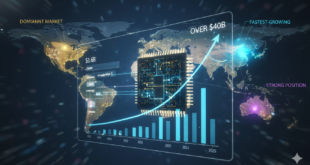Quantum Computing: The Next Giant Leap in Technology Innovation
Explore how quantum computing is evolving from research labs into a global technological powerhouse, reshaping industries and unlocking future possibilities.
Quantum computing, once a theoretical endeavor, has rapidly transitioned into a burgeoning field, signaling a maturity that may surpass common perceptions. This evolution is underscored by a significant surge in patent filings and technological advancements, reflecting a dynamic and interconnected research ecosystem.
Global Investment
Quantum computing promises exponential acceleration of potential solutions to the complex problems of climate change, energy crisis and food security by modeling intricate interactions at the quantum level and crunching massive amounts of data that classical computers have not and may never solve.
Quantum computing is undergoing a critical transformation. Once a field dominated by theoretical physics and fundamental research, it is now moving toward practical applications, commercialization, and large-scale infrastructure development. Governments, industries, and research institutions worldwide are making significant investments in quantum technologies, recognizing their potential to revolutionize computing, communications, and security.
Quantum technology has become a strategic enabler for many nations, primarily because it has the potential to disrupt various sectors, including cybersecurity, material sciences, drug discoveries and finance. While a global ecosystem effort is needed to successfully develop and deploy quantum technologies, the current state of efforts is concentrated in certain countries. Governments, especially those in Japan, the United Kingdom, the United States, and China, have formulated research policies and poured monies to turn quantum science into enabling technologies that will, in turn, boost economic activities.
Quantum science and technology currently attracts around US$40 billion (HK$312 billion) in research and innovation funding from the worldwide public sector, according to the Quantum Economy Blueprint published by the World Economic Forum in January 2024. The Blueprint reports also found that only 24 nations had some form of national initiative or strategy to support quantum technology development by the end of 2023.
Global powers, led by China, have invested more than $55 billion in the promising technology and we are closer than ever to realizing the $500 million to $1 billion in gains that quantum promises to deliver to businesses over the next fifteen years. China’s investment in quantum technology is also significant, with an estimated US$25 billion in government investment from the mid-1980s through 2022.
In Japan, the government is providing 4.2 billion yen (HK$206 million) to support a quantum computing collective led by the University of Tokyo.
The UK government has set an ambitious national quantum strategy with a goal of achieving a quantum-enabled economy by 2035. To this end, 2.5 billion (HK$24.67 billion) has been earmarked for the development of quantum technologies over 10 years from 2024. In Europe, Germany has launched an investment plan of more than $3 billion by 2026, and France has announced an investment of nearly $2 billion, aiming to train 5,000 quantum-ready engineers and create 30,000 jobs.
The United States has been investing significantly in quantum information science research and development through the National Quantum Initiative Act. In the United States, the National Quantum Initiative Act has authorized $1.2 billion in funding over five years for quantum computing research and development.
Patent Trends Indicating Maturity
Recent analyses reveal a notable acceleration in quantum computing patent activities. The European Patent Office’s insight report highlights a substantial increase in patent applications related to quantum technologies, particularly in areas like physical realizations of quantum computing and quantum error correction.
Similarly, data indicates that the annual quantum computing patent filings have experienced a compound annual growth rate (CAGR) of 25% over the past decade, underscoring the rapid pace of innovation in this sector.
This surge in patent filings is not merely quantitative but also qualitative, reflecting advancements in critical components such as qubits, quantum gates, and quantum algorithms. The proliferation of patents in these domains suggests a transition from theoretical research to practical applications, marking a pivotal shift towards technological maturity.
Study analyzes intellectual property trends
A study published in the Journal of the Knowledge Economy by Mario Coccia and Saeed Roshani delved into intellectual property trends to assess the maturity of quantum computing technologies. By analyzing patent data, the researchers aimed to understand the evolutionary dynamics of this cutting-edge domain.
The researchers employed a comprehensive approach, utilizing the Derwent Innovation Index (DII) and logistic growth models to evaluate the progression of quantum computing technologies.
Derwent Innovation Index (DII) Logistic Growth Model and Inflection Point
To assess the maturity of quantum computing, the researchers utilized the Derwent Innovation Index (DII) from the Web of Science database. The DII is a proprietary patent research application provided by Clarivate Analytics. It offers access to the Derwent World Patents Index (DWPI), a curated patent database with editorially curated titles and abstracts, special subject matter classification coding and indexing, and proprietary patent invention-centric family building. The DII also includes the Derwent Patent Citation Index (DPCI), which indexes backward and forward patent and literature citations. This resource enables users to monitor technology trends, competitive landscapes, and inform freedom-to-operate opinions, among other functionalities.
This comprehensive resource encompasses over 14.3 million inventions from nearly 60 global patent-issuing authorities, providing a robust foundation for analyzing technological trends. By examining the accumulation and interrelation of patents, the study sheds light on the evolutionary dynamics of quantum computing.
To analyze the growth trajectory of quantum computing patents, the researchers applied a logistic growth model. This model is characterized by an initial exponential growth phase, followed by a slowdown as the system approaches a saturation point, forming an S-shaped curve. The inflection point of this curve is particularly significant; it represents the moment where the growth rate transitions from acceleration to deceleration.
The study revealed that quantum computing technology has reached a mature phase, marked by a sharp increase in the number of patents filed since 2016. This surge underscores significant progress and development in the field. Notably, critical research areas such as qubits, quantum gates, quantum information, and quantum dots have experienced rapid growth. These domains are essential for the advancement of quantum computing technology and highlight its evolution and importance.
The analysis revealed that quantum computing’s growth is marked by increasing interactions among various topics within the field. This interconnectedness has fostered a dense network of research and technological development, facilitating cumulative knowledge and innovation. The researchers concluded that the evolutionary dynamics of quantum computing co-evolve with endogenous processes that support high interactions with various topics within the network. This increases the extension and density of connections with interrelated research fields and technologies, enriching our theoretical understanding of how scientific and technological fields evolve. Key areas such as qubits, quantum gates, quantum information, and quantum dots have experienced rapid growth, underscoring their significance in the advancement of quantum technologies. The study emphasizes the role of vital topics in fostering interconnections and cumulative knowledge over time.
The rapid accumulation of patents and the dense network of interrelated research areas suggest that quantum computing is progressing swiftly, moving beyond its nascent stages into a more established and interconnected technological domain.
Beyond patent analysis, several other factors underscore the maturation of quantum computing
Technological Advancements:
Beyond intellectual property metrics, the quantum computing landscape has witnessed significant technological milestones. Companies like IBM have launched advanced quantum systems, enhancing performance and scalability, thereby enabling researchers to tackle complex problems across various fields, including medicine and artificial intelligence.
Recent years have witnessed remarkable progress in quantum computing hardware and software. In February 2025, physicists unveiled an eight-qubit topological quantum processor, marking a significant leap forward in the field. This processor serves as a proof-of-concept, demonstrating the feasibility of more stable and scalable quantum systems
Hardware developments further attest to quantum computing’s maturity. The number of physical qubits on quantum circuits has been doubling every one to two years since 2018, indicating significant technological progress. This exponential growth is expected to continue, enhancing the computational capabilities of quantum systems.
Additionally, the introduction of performance metrics such as Quantum Volume and Circuit Layer Operations Per Second (CLOPS) provides standardized benchmarks to evaluate and compare quantum processors, facilitating objective assessments of their readiness for complex problem-solving.
Market Growth
The financial landscape reflects growing confidence in quantum computing’s potential. The quantum market is already estimated to be worth more than $1 billion this year, even though quantum computers are not yet very useful. Despite a general downturn in tech investments, quantum computing attracted $1.2 billion from venture capitalists in 2023, underscoring continued investor confidence in its future. Additionally, industries such as pharmaceuticals are at the learner level of quantum maturity, indicating early adoption and integration of quantum technologies
Industry Engagement and Industry Transition
Companies like IonQ are shifting from pure research and development to operational and engineering phases. Peter Chapman, CEO of IonQ, noted a cultural shift from an academic organization to an engineering-focused company, indicating a move towards practical applications and product development.
For example, Quantinuun, a company formed in 2021 by Honeywell and Cambridge Quantum, has upgraded its processor of qubits for accelerating fault tolerant quantum computing for commercial customers like JPMorgan Chase.
Moreover, companies like Nvidia are actively contributing to the quantum ecosystem. Nvidia announced the creation of the Nvidia Accelerated Quantum Research Center (NVAQC) in Boston, aiming to integrate quantum hardware with traditional supercomputers. This initiative seeks to address challenges such as qubit noise, which has hindered commercial adoption, by leveraging the strengths of both quantum and classical computing systems
Additionally, collaborations between tech giants and industry leaders, such as the partnership between Boehringer Ingelheim and Google Quantum AI in pharmaceutical research, exemplify the practical integration of quantum technologies into commercial applications.
Banks, hedge funds, and car manufacturers are recruiting specialized quantum teams. They are tackling the construction of algorithms coded in qubits for their strategic applications. They are forming partnerships with quantum computer manufacturers – IBM, Atos, Pasqal – and academic research centers. These companies will be ready for the day when manufacturers offer sufficiently powerful machines. The aim is to increase the number of high-quality qubits and reduce error rates, eventually multiplying the power of the best current prototypes by a thousand.
Standardization Efforts:
The development of metrics such as Reliable Quantum Operations Per Second (rQOPS) reflects efforts to standardize performance measurements in quantum computing. rQOPS considers factors like logical error rates, clock speed, and the number of reliable qubits, providing a comprehensive assessment of a quantum computer’s capabilities. Microsoft’s suggestion that a machine with 1 million rQOPS qualifies as a quantum supercomputer illustrates the strides toward benchmarking and standardization, essential components of a maturing industry.
Collectively, these indicators demonstrate that quantum computing is progressing beyond its nascent stages, moving toward a more mature and commercially viable technology. The convergence of increased patent activity, industry shifts, economic forecasts, job creation, and standardization efforts all point to a technology on the cusp of broader adoption and integration into various sectors.
Global Economic Implications
The maturation of quantum computing holds profound economic implications. Projections suggest that quantum technologies could generate substantial economic value, with estimates reaching up to $850 billion by 2040. This anticipated growth is attributed to quantum computing’s potential to revolutionize sectors like cryptography, optimization, and complex system simulations, offering unprecedented computational capabilities.
Economic Projections:
The Boston Consulting Group projects that quantum computing could create $450 billion to $850 billion in economic value by 2040, supporting a market of $90 billion to $170 billion for hardware and software providers. This substantial economic potential reflects the technology’s growing viability and anticipated impact across various sectors.
Market Growth:
Forecasts indicate significant expansion in the quantum computing market. For instance, Fortune Business Insights projects growth from $928.8 million to $6.5 billion by 2030, while Omdia reports an expected increase from $1.1 billion in 2023 to $28.2 billion in 2033, at a compound annual growth rate of 37.7%. These projections highlight the escalating investment and interest in quantum technologies
Job Creation:
The quantum sector is expected to generate approximately 250,000 new jobs by 2030, increasing to 840,000 by 2035. This anticipated job growth underscores the industry’s expansion and the increasing demand for a skilled workforce to support quantum advancements.
Challenges and Future Outlook
Despite these advancements, challenges persist in achieving widespread quantum computing adoption. Issues such as qubit stability, error correction, and the development of scalable quantum architectures remain focal points for ongoing research. Moreover, the looming threat of quantum-enabled cyberattacks has prompted cybersecurity agencies to advocate for the adoption of quantum-resistant encryption methods, emphasizing the need for proactive measures to safeguard digital infrastructures.
Since quantum computing is still an emerging field, companies will need to collaborate with academic institutions, technology providers, and quantum research organizations to keep up with the latest advancements and integrate cutting-edge solutions. Building a multidisciplinary team with these areas of expertise takes planning and time.
Conclusion
In conclusion, the convergence of increased patent activity, technological breakthroughs, and strategic industry collaborations indicates that quantum computing is advancing towards a more mature and integrated phase. As research continues to address existing challenges, the trajectory of quantum technologies points towards transformative impacts across various sectors, heralding a new era of computational innovation.
References and Resources also include:
https://www.forbes.com/sites/sylvainduranton/2024/06/26/quantum-now/
 International Defense Security & Technology Your trusted Source for News, Research and Analysis
International Defense Security & Technology Your trusted Source for News, Research and Analysis




